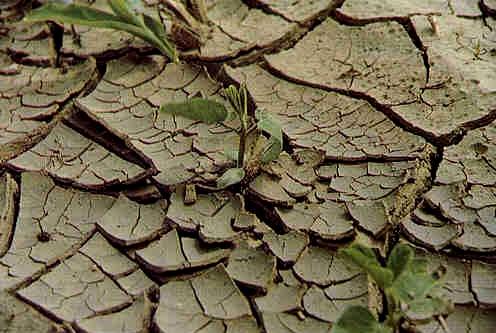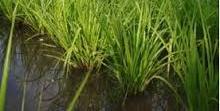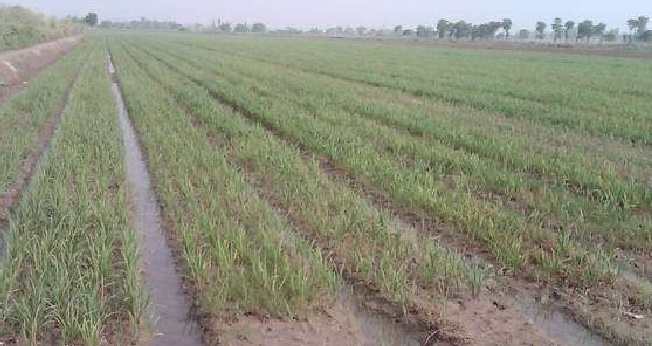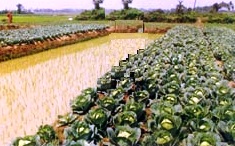टिकाऊ फसल उत्पादन में मृदा भौतिक दबाव और उनके प्रबंधन के विकल्प
Enhanced soil productivity and assured sustainability are the two major concerns to feed the increasing population of the modernized world. Scientific planning and management practices for further enhancement and sustaining of the productive potential of soils, however, require a proper understanding of the factors limiting its productivity.
About 1704.68 lakh ha of land areas of our country at present is affected by various soil problems. A number of soil physical constraints result into unfavorable soil environment for nutrient availability and utilization by crops.
The physical fertility describes state of soil in respect of flow of water and air, thermal regimes and mechanical resistance to growing seedlings and roots. The adverse physical soil environment limits root growth and its activity and results in reduced nutrient absorption and growth of plants (Peterson et al., 1984).
Such physical degradation of soils had affected significant chunk of fertile tracts, particularly in the Indo-Gangetic plains and caused significant loss to crop productivity.
The major soil physical constraints limiting the crop production which either restrict the crop growth or reduce the efficiency of basic inputs are-
Highly permeable soils:
Highly permeable coarse textured soils which are characterized by low water retention, excessive permeability and poor inherent fertility are also prone to wind erosion. In these soils, the fertilizer use efficiency is very low and the nutrient losses are very high discouraging the use of high levels of inputs. These soils usually have high sand content and having high basic infiltration rates.
 Crusting soils:
Crusting soils:
Some soils are prone to form a hard crust on its surface on drying after rain showers due to reorientation of dispersed soil particles on wetting and differential sedimentation. The crust formation is a serious problem in sandy loam and loamy sand soils having low organic matter content.
The emergence of seedling in crops like pearl millet, cotton, sorghum, mustard etc. is reduced drastically when rain showers occurs within one or two days of seeding.
Soils with sub-surface mechanical impedance:
Dense layer may develop either due to formation of a plough sole as in the case of rice fields on medium textured soil, use of heavy machinery on a moist soil or presence of kankar (calcium carbonate) layers.
Presence of such layers at shallow depths affects the plant growth by restricting root penetration to sub-soil for their moisture and nutritional requirements.
These layers are relatively impervious and as a result water may stagnate on the soil surface after heavy rainfall or irrigation causing oxygen stress to the crops. Thus, shallow root system makes the plant drought prone during dry spells and promotes lodging during unusually wet conditions.

Rice soils
Rice is usually grown in puddled soils. Intensive puddling deteriorates the soil structure and creates problem for subsequent crops say for wheat crops in rice-wheat cropping system.
Use of heavy machinery for puddling of soils may increase the compaction with high bulk density values of puddled rice soils. High bulk density decreases the infiltration rate and confines the crop root in top layer which reduce the volume of soil that can be explored by the plant for nutrient and water.
Management options:
The soil physical constraints limiting nutrient utilization and crop production could be alleviated by adopting certain soil management practices that moderate soil environment. The adoption of such practices may be of more value for dry land areas facing frequent moisture stress and having low fertilizer use efficiency.
The practice of covering soils with waste organic residues greatly aids in moderating soil hydro-thermal regimes and enhancing nutrient availability. Generally, the soils with sand fraction more than 70 % exhibit high permeability (Infiltration rate> 20 cm/day). These soils have low water retention and frequent nutrient loss with percolating waters.
To reduce deep percolation losses and enhance soil moisture storage capacity of highly permeable sandy soils, application of bentonite clay, fine textured soils or pond sediments (Gupta and Nagarajarao, 1982) and placement of asphalt barrier at shallow depths (Gupta and Aggarwal, 1980) have been attempted.
Application of FYM on seed lines as mulch is very helpful in reducing the ill-effects of surface crust on seedling emergence and crop establishment in crust prone sandy loam and loamy sand soils. Upon mulching, the yield of pearl millet and cotton increases. Thus, FYM seed line mulch reduces the impact of rain drops and prevents the formation of the crust, improves the seedling emergence and yield of crops.
The presence of sub-soil hard pan impedes movement of water and air in the soil, restricts root growth and reduces uptake of nutrients. In this situation, breaking/shattering of the compact layers improves the nutrient availability and yields of crops.
The management practice to be followed depends on the depth of occurrence of hard pan. Tillage operations carried out with various implements like chisel plough, disc harrows etc. are useful for breaking of hard pan in sub-soil layers.
Soils with slow permeability adoption of raised and sunken bed technique is useful. This involves the growing of crops in 20cm high and 3m wide raised beds adjacent to 20cm and 6m wide sunken beds. Furrow irrigated raised bed planting system (FIRBS) for improving soil physical environment and resource use efficiency has been found to be a useful technology.

Broad Bed Furrows Planting System

Raised and Sunken Bed Method
For sustain the productivity of rice soils by application of organic amendments and crop residue management suggested that the organic amendments significantly increases the yield of rice and wheat due to enhanced nutrients supply and improvement in soil physical conditions (Beri et al., 1989; Joshi et al., 1994). Leguminous green manures during puddling for growing paddy have been found successful.
References:
- Beri, V., Meelu, O.P and Khind, C.S. 1989. Studies on Sesbania aculeata Pers. As green manure for N-accumulation and substitution of fertilizer-N in wet land rice. Tropical Agriculture, (Trinidad) 66: 209-212.
- Gupta, J.P and Aggarwal. R.K. 1980. Use of the asphalt sub-surface barrier for improving the productivity of desert sandy soils. Journal of Arid Environment, 3:215.
- Gupta, J.P and Nagarajarao, Y.1982. Soil structure and its management, Review of soil research in India, Part I. 12th Intern. Cong. Soil Science, New Delhi, p. 60.
- Hillel, D. 1980. Fundametals of Soil Physics. Academic Press, New York, pp.7-8.
- Joshi, R.C., Haokip, D.D and Singh, K.N. 1994. Effect of green manuring on the physical properties of soil under a rice-wheat cropping system. Journal of Agricultural Science, (Cambridge) 122:107-113.
- Peterson, C.M., Klepper, B., Pumphrey, F.V and Rickman, R.W. 1984. Restricted rooting decreases tiltering and growth of winter wheat. Agronomy Journal, 76: 861-863.
Author (s)
Dhaneshwar Padhan1*, Arbind Kumar Gupta1, A. Krishna Chaitanya1 and Shyam Prasad Majumder1
1Department of Agricultural Chemistry and Soil Science, Bidhan Chandra Krishi Viswavidyalaya, West Bengal- 741252
*E-mail of corresponding author:
